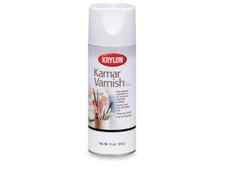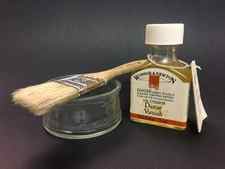Watercolor paper storage is always a headache for many artists. To keep it for a long time with original quality, you have to choose high-quality watercolor paper such as conservation grade or archival papers with acid-free features.
How To Store Watercolor Paintings? 6 Tips To Protect Watercolor Paintings

Watercolor painting is one of the most sensitive forms of art since the watercolor paint is easily disturbed and ruined, and the paper is relatively brittle. However, there are still some famous paintings from the 15th century which are now still in good condition such as famous Lascaux Cave paintings in southwestern France . You may wonder why those paintings can last for such a long time and how to store watercolor paintings on other surfaces. This article will show you some helpful recommendations.
Choosing high-quality materials
How to preserve watercolor paintings with materials preparation? In reality, materials used for watercolor paintings can have a significant impact on the quality and shelf-life of paintings. Therefore, you should choose them carefully from the beginning.
Use acid-free (or PH neutral) materials

All the materials that are directly in contact with your artwork should be acid-free. Acid can cause yellowing and degradation over time, which is accelerated when heat and sunlight are involved. The paper used for your painting is not an exception.
Nowadays, acid-free paper is now the industry standard for high-quality art paper. Therefore, when looking for the perfect paper, you should consider either conservation grade paper which is wood-based pulp, or archival paper which is cotton pulp such as Fabriano papers . Both of them are acid-free and excellent materials for your artwork.
Use lightfast, pigment-based materials

Another material for watercolor paintings is watercolor paint which has a significant impact on the painting’s quality and longevity. The bright colors of dyes are well-known, but they fade quickly. On artist-quality paints, lightfastness ratings, often known as permanence, are always displayed. These are either expressed by ASTM ratings or the Blue Wool Scale on a scale of 1 to 8.
Daniel Smith watercolor is a popular variety that is classified as an outstanding watercolor paint with lovely semi-transparent color according to ASTM criteria.
Derwent watercolor pencil is another good choice with high-quality lightfast watercolor .
It would be a big mistake if we don’t mention Sennelier French watercolor which is also a frequent choice of the most renowned artists in the world since they have been reformulated with increased honey content for enhanced brilliance and luminosity.
Maintain cleanliness while painting

It is important to maintain cleanliness during painting since it can help you keep your paintings longer. The reason is that cleanliness eliminates dust, food residues, and smoke, all of which can damage your artwork.
Besides, try to not touch your painting surface and clean your hand carefully before painting. Fingerprints on paper can resist water and paint, resulting in uneven work.
Furthermore, the paper, paint, water, and canvas should all be free of oil and fingerprints. Finally, make sure to clean the brushes as well as the rest of the equipment after using them.
Why Varnish a Painting?

What are we protecting our paintings from anyway? Well air, for one thing. Air contains a variety of pollutants that cling to the surface of a painting. Over time these pollutants will alter the colors. Besides the air, we protect our paintings from moistures, liquids, dust, and other contaminants as well. Spills, sneezes, and even humidity can contribute to the deterioration of a painting.
Varnishing a painting may seem like a permanent alteration, but it’s not. After a varnished painting has lost it’s luster over time, the varnish layer can easily be removed, taking the built-up of pollutants and particles with it. (As a general rule, varnish should be removed and reapplied every fifty years or so.)
Beyond protection, there’s another good reason to varnish a painting and it deals with aesthetics. By applying varnish, we create a unified surface. Sometimes a finished painting will have both shiny and dull areas. This distracting variance can happen for several reasons…

1. Mixing paint brands. Different brands of paint use different ratios of ingredients (binder/pigment). Some brands use “filler” materials as well. This inconsistency results in a ranging level of sheen.
2. Medium. Oil painters often use medium to control the viscosity of their paint. Some medium(s) are glossy. Unless your paint has the same amount of medium in each stroke you are likely to end up with an uneven surface.
3. Glazing. Glazing is a wonderful technique used to create subtle, gradual changes in color. A glazed layer of paint will dry glossy. If you glaze only parts of your painting you will definitely need to use a coat of varnish to even out the surface sheen.
Thankfully, when varnish is applied, it eradicates these inconsistencies and we are left with a painting that not only is protected, but also looks great.

Types Of Varnish

The type of varnish that you choose depends on the type of finish that you desire. Some varnishes dry to glossy finish and make the colors more intense, while others dry to an even matt finish and mute the colors.
Without a doubt, the number one varnish used on oil paintings is Damar Varnish. It is made from only damar resin, turpentine, and alcohol. Damar varnish dries to a high gloss finish and can be applied with a brush or as a spray.
As the name implies, this form of varnish dries to a high gloss finish. This varnish can be applied with a brush, but it is also available as a spray which some folks may prefer.
Matt varnish dries to a flat finish without any gloss or shine. You won’t get any reflection with this varnish, but the colors will look duller. This varnish can be brushed on or applied as a spray.
Satin varnish dries to a semi-gloss finish. If you’re looking for a slightly glossy finish, but high gloss is a little too strong, you may consider this varnish.
Retouch varnish is used during the painting process to even out the sheen of a painting. Retouch varnish is also used to refresh dull areas of an older painting that has already been varnished.
The Acrylic Painting Academy
“The Acrylic Painting Academy” is a comprehensive painting course designed to guide absolute beginners to a level of producing professional quality acrylic paintings.
VIEW COURSE
Some Varnishes are Medium Specific
There are other factors to consider besides just the finish. You also need to consider the painting medium.
While traditional varnishes like Damar varnish, are recommended for oil paintings, it is suggested to use a specially formulated varnish for acrylics or water-mixable oils. Manufacturers have developed special varnishes for acrylics that can be removed. These varnishes are brushed on. Spray varnishes can be used for these types of paintings but it may be hard to remove the varnish if you need to in the future.
For water mixable oils, Winsor and Netwon recommend their Artisan varnishes which are available in a range of finishes including gloss, matt, and satin.





